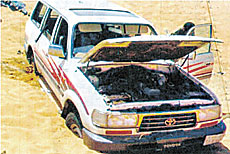WADI AL-DAWASIR, 6 July 2007 — In the last 18 months, bodies of 49 people have been found in the Al-Muhmil desert, locally known as the “Desert of Death”.
Asharq Al-Awsat, a sister publication of Arab News, recently reported that the number of people losing their way crossing the desert, which is located to the east of Wadi Al-Dawasir and close to the Empty Quarter, is rapidly increasing. Although the authorities have been able to locate and help some of those who lose their way, many others have simply vanished into thin air.
In fact, the Al-Muhmil desert is a popular topic of conversation among locals, who have all sorts of stories to tell. Locals have even named parts of the desert after loved lost ones. “This is Hadi’s area,” said one old man, referring to a relative who got lost in this particular part of the desert some 15 years ago. Another area was named Muhsin, and another part was called Al-Tamim after a family that vanished there.
Victims include Saudis, expatriates and illegal migrants, who try crossing the desert to avoid the authorities. Recently two men and a woman went missing crossing the desert. The two men died while the woman was found dehydrated and unconscious 27 hours later. Last year, Abdullah Al-Dawasri, a Saudi Air Force man, lost his way in the desert and was lucky to be found alive a week later.
These are just some of the few individuals, who have been found in the Al-Muhmil desert. Search teams that enter the desert looking for lost people often come across bodies of people who lose their way there.
“It’s a dangerous piece of terrain — 500 km wide and 800 km in length. Security checkpoints needs to be established to prevent people entering it,” said Hamoud Al-Dawasri, a local Saudi citizen.
Mubarak Al-Sharida, manager of the Wadi Al-Dawasri Hospital, said that the hospital often receives people suffering from dehydration after having got lost in the desert. “People who cross the desert are often unaware of roads inside and so get lost,” he said.
Aadi Al-Bugami, a police official, said: “It’s a dangerous place. A lot of overstayers seem to get lost inside it. They usually risk crossing it to avoid the authorities. Legal expatriates and some Saudis also get lost. These are mainly people who are unaware of the danger that the desert poses.”
He added: “The new road between Rania and Wadi Al-Dawasri has considerably reduced the danger.”
On Sept. 11, 2006, Arab News reported how a desert nomad made the grim discovery of finding the bodies of a woman and her three children, who had been missing for over three months in the southern part of the Al-Ulayem desert, about 40 km north of the Hail-Jouf highway.
At the time, police launched a massive search for the family using helicopters to scour the area. The body of the woman’s husband, who worked as a prison guard, has still not been found. According to police, the man was transferred to the Al-Kurayyat prison from Hail and had likely lost his way when he decided to take a shortcut through the desert. Police officers say that the family probably died as a result of thirst and dehydration.
The story of the family shocked residents in Hail. Initial reports had suggested that in desperation the family even drank the car coolant to battle their thirst. Police officers found one of the children in the back of the car dead and covered with a blanket, indicating that he might have died first and that his mother had put him in the back and then covered him with a blanket. The other two children were found in the back seat hugging each other while the mother was found lying next to the car, which shows that she might have been searching for water before she collapsed. Police also found a piece of paper with the woman, in which she described the last moment of their lives.
Capt. Saad Al-Muhareb of the Hail police told Arab News last year that following the discovery of the jeep, police officers searched for the body of the father. “We have called for an airplane to search for the missing man and we hope that we will find traces of him,” he said, adding that it is more than likely that the man was dead and that his body was buried under the sand because the accident happened a long time ago.
According to the British Embassy website, people are advised never to drive off-road in two-wheel-drive vehicles and that when driving into the desert, one should always go in a group of at least three four-wheel-drive vehicles. People planning to drive off-road should always tell someone their route and expected time of return, and carry at least five liters of water per person per day on desert trips.
Outside in a temperature of 40 degrees, an adult man of average built completely dehydrates in just two hours. People traveling off the beaten track should always use local guides, seek local advice and avoid traveling after dark.
When traveling in the desert, people should drink even when they do not feel thirsty, store extra water, wear a hat with a brim and light-colored, lightweight clothes, wear sunglasses and sunblock, ensure your car is in good working order, carry spare tires and regularly fill up on gas.


